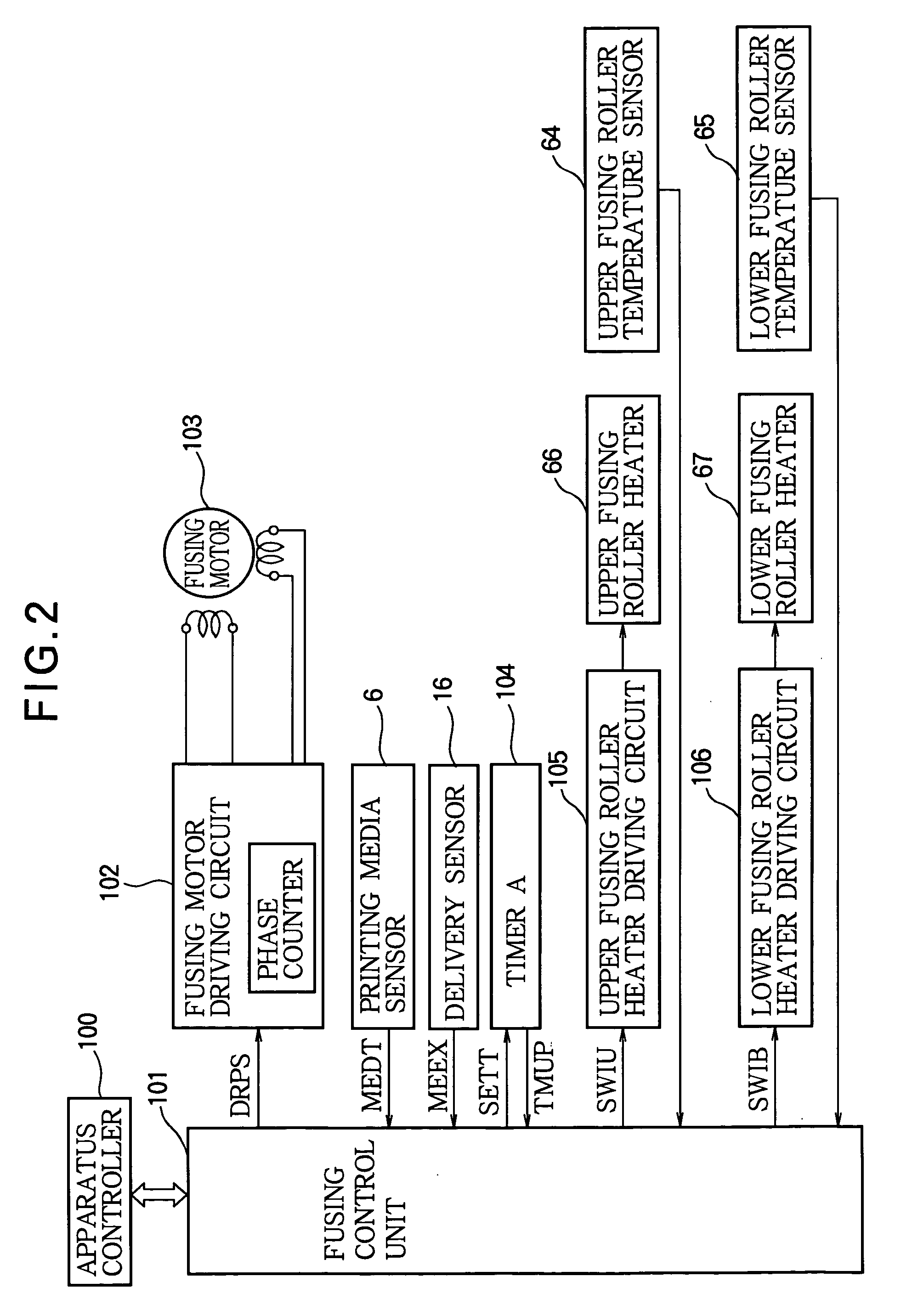Image processing apparatus with preheating control
a technology of preheating control and image processing, applied in the direction of electrographic process apparatus, instruments, optics, etc., can solve the problems of hot offset, irregular gloss, and possible inadequate fusing, and achieve the effect of stable fusing temperatur
- Summary
- Abstract
- Description
- Claims
- Application Information
AI Technical Summary
Benefits of technology
Problems solved by technology
Method used
Image
Examples
first embodiment
[0025] Referring to FIG. 1, the image processing apparatus 1 in the first embodiment is a two-sided color printer with a printing process unit 2 having black (K), yellow (Y), magenta (M), and cyan (C) developing units 2a, 2b, 2c, 2d and corresponding transfer rollers 2f. Printing media can be fed into the printing process unit 2 from either a cassette 3 or a double-sided paper feeding unit 4. Before entering the printing process unit 2, the printing media are aligned by a registration roller 5 and detected by a printing media sensor 6. Within the printing process unit 2, the printing media are transported by a transport belt 8, which carries the printing media between a photosensitive drum in each developing unit 2a, 2b, 2c, 2d and the corresponding transfer roller 2f. The printing process unit 2 functions as the image forming unit by forming black, yellow, magenta, and cyan toner images on the photosensitive drums in the developing units 2a, 2b, 2c, 2d and transferring the toner im...
second embodiment
[0051] The second embodiment is a color printer having the mechanical configuration shown in FIG. 1 and the control system shown in FIG. 6. The second embodiment differs from the first embodiment in the addition of a second timer B 114 to the control system. The fusing control unit 101 in FIG. 6 uses timer B to decide whether or not to execute the preheating process, instead of making this decision by comparing the fusing roller surface temperatures with a threshold temperature as in the first embodiment.
[0052] Like timer A 104, timer B 114 receives a set-time signal SETT from the fusing control unit 101, measures a corresponding interval of time, and returns a time-up signal TMUP to the fusing control unit 101 at the end of the interval. The fusing control unit 101 uses timer B to measure a post-fusing interval Td starting from the time at which the delivery sensor 16 recognizes the trailing edge of the printing paper 15. The fusing control unit 101 executes the preheating process...
third embodiment
[0069] The third embodiment is a color printer having the mechanical configuration shown in FIG. 1 and the control system shown in FIG. 9. The third embodiment differs from the first embodiment in the addition of an average heater-on time calculator 107 to the control system. The fusing control unit 101 in FIG. 9 uses the average heater-on time calculator 107 to decide whether or not to execute the preheating process, instead of making this decision by comparing the fusing roller surface temperatures with a temperature threshold.
[0070] The average heater-on time calculator 107 receives the switching signals SWIU and SWIB output from the fusing control unit 101 to the roller heater driving circuits. At regular averaging intervals, the average heater-on time calculator 107 calculates the average percentage of time during which each of the roller heaters has been turned on during the preceding averaging interval. The calculated average heater-on times of the upper and lower fusing rol...
PUM
 Login to View More
Login to View More Abstract
Description
Claims
Application Information
 Login to View More
Login to View More - R&D
- Intellectual Property
- Life Sciences
- Materials
- Tech Scout
- Unparalleled Data Quality
- Higher Quality Content
- 60% Fewer Hallucinations
Browse by: Latest US Patents, China's latest patents, Technical Efficacy Thesaurus, Application Domain, Technology Topic, Popular Technical Reports.
© 2025 PatSnap. All rights reserved.Legal|Privacy policy|Modern Slavery Act Transparency Statement|Sitemap|About US| Contact US: help@patsnap.com



